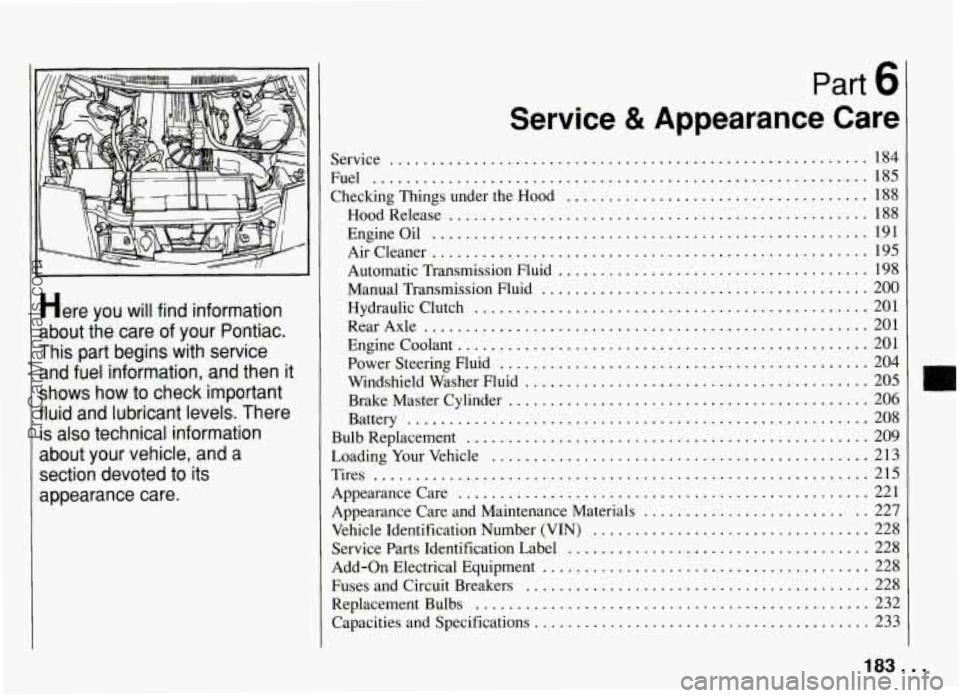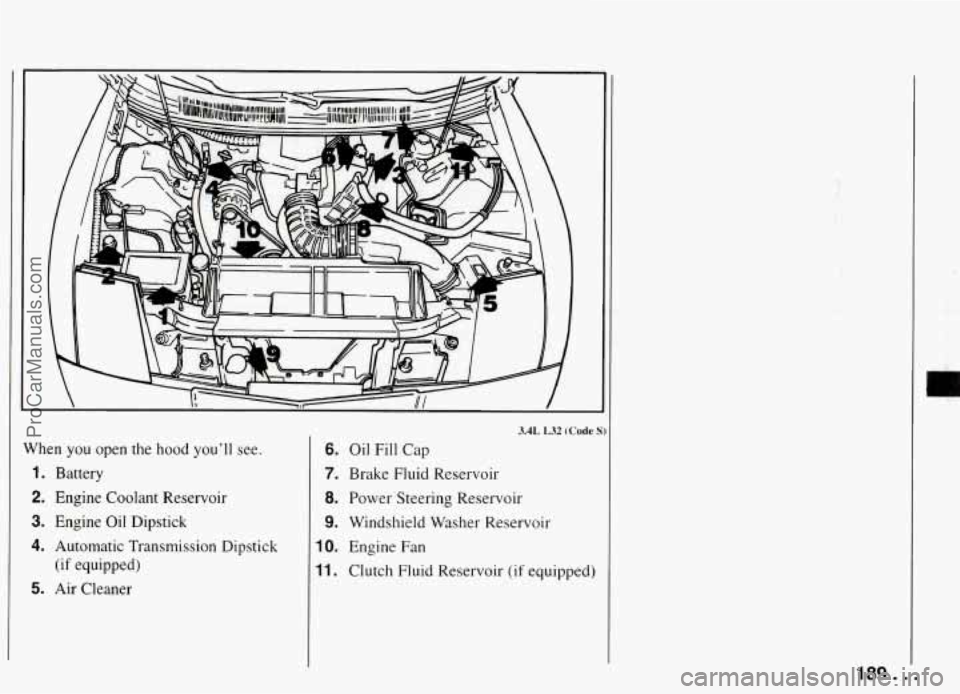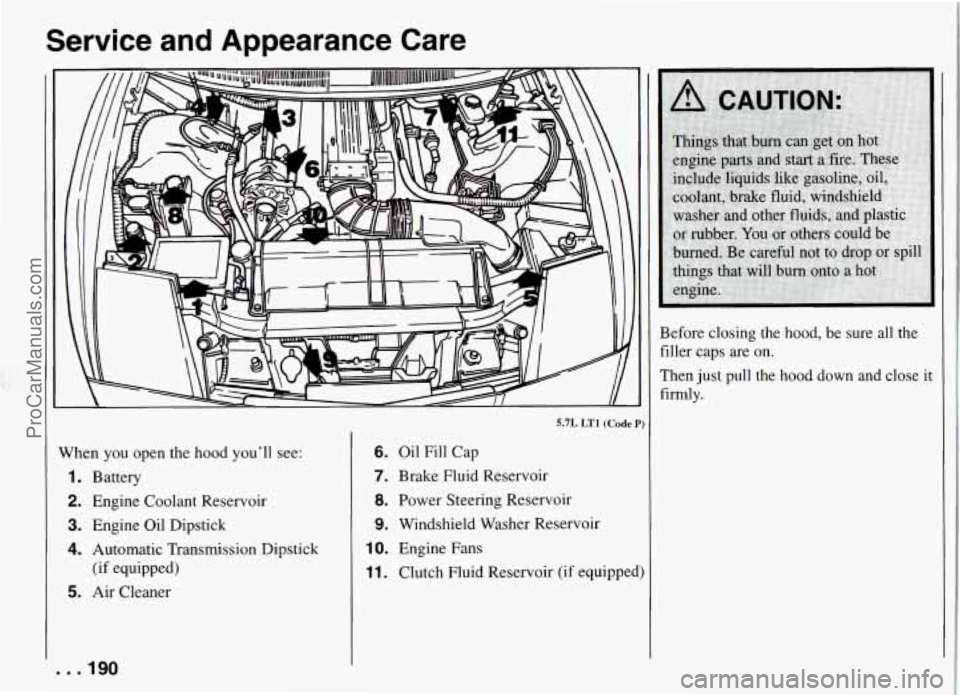engine PONTIAC FIREBIRD 1994 Workshop Manual
[x] Cancel search | Manufacturer: PONTIAC, Model Year: 1994, Model line: FIREBIRD, Model: PONTIAC FIREBIRD 1994Pages: 290, PDF Size: 14.84 MB
Page 166 of 290

How to Add Coolant to the Radiator
:3.4L L32 (Code S) Engine)
I. You can remove the radiator pressure
cap when the cooling system,
including the radiator pressure cap
and upper radiator hose, is no longer
hot. Turn the pressure cap slowly to
the left until it first stops. (Don't pres:
down while turning the pressure cap.)
If you hear a hiss, wait for that to stor
A hiss means there is still some
pressure left.
2. Then keep turning the pressure cap,
but
now push down as you tum it.
Remove the pressure cap.
165 ...
ProCarManuals.com
Page 168 of 290

6.
7.
Start the engine and let it run until
you can feel the upper radiator hose
getting hot. Watch out for the engine
fan(s).
By this time the coolant level inside
the radiator filler neck may be lower.
If the level is lower, add more of the
proper
mix through the filler neck
until the level reaches the base of the
filler neck. Then
replace the pressure cap. At any
time during this procedure if coolant
begins
to flow out of the filler neck,
reinstall the pressure cap. Be sure the
arrows on the pressure cap line up likl
this.
How to Add Coolant to the Radiator
(5.7L LT1 (Code P) Engine)
NOTICE:
The LTl engine (Code P) has a
specific radiator fill procedure.
Failure to follow this procedure
could cause your engine to overheat
and be severely damaged.
167 ...
ProCarManuals.com
Page 169 of 290

Problems on the Road
1. You can remove the radiator
pressure cap when the cooling system
including the radiator pressure cap
and upper radiator hose, is
no longer
hot.
Turn the pressure cap slowly to
the left until it first stops. (Don? pres5
down while turning
the pressure cap.)
If you hear a hiss, wait for that to stop
A hiss means there is still some
pressure left.
2. Then keeb turning the pressure cap,
but now push down
as you turn it.
Remove the pressure cap.
5. After the engine cools, open the air
bleed valves on the heater return hose
and water pump inlet.
. . .168
ProCarManuals.com
Page 170 of 290

4. Fill with the proper mix. Add coolant
until you see a steady stream of
coolant coming from the bleed valves.
5. Close the bleed valves.
i. Continue to fill the radiator up to the *
base of the filler neck.
’. Rinse or wipe the spilled coolant from
the engine and compartment.
I. Start the engine and allow it to run in
idle
for approximately four minutes.
By this time, the coolant level inside
the radiator will be lower. Add more
of the proper mix through the filler
neck until the level reaches the bdse
of the filler neck.
169 ...
ProCarManuals.com
Page 171 of 290

Problems on the Road
9. Shut the engine off and replace the
pressure cap. Be sure the arrows
on
the cap line up like this.
I
0. Then fill the coolant recovery tank to
;or a complete drain, flush and refill, see
‘our Pontiac dealer or a Pontiac Firebird
Iervice Manual. To purchase a service
nanual, see “Service Publications’’ in
he Index. the proper
level.
If a Tire Goes Flat
[t’s unusual for a tire to “blow out” while
you’re driving, especially
if you maintain
your tires properly. If air goes out of a
;ire, it’s much more likely to leak out
jlowly. But if you should ever have a
‘blowout,” here are a few tips about what
:o expect and what to do:
[fa front tire fails, the
flat tire will create
3 drag that pulls the vehicle toward that
side. Take your foot off the accelerator
pedal and grip the steering wheel firmly.
Steer to maintain lane position,
then
gently brake to a stop well out of the
traffic lane.
A rear blowout, particularly on a curve,
acts much like a
slud and may require the
same correction you’d use in a skid. In
any rear blowout, remove your foot from
the accelerator pedal. Get the vehicle
under control by steering the way you
want the vehicle to go.
It may be very
bumpy and noisy, but you can still steer.
Gently brake to a stop, well
off the road
if possible.
[f a tire goes flat, the next section shows
how to use your jacking equipment to
change a flat tire safely.
. . .I70
ProCarManuals.com
Page 184 of 290

I I
Here you will find information
about the care of your Pontiac
.
This part begins with service and fuel information. and then
it
shows how to check important
fluid and lubricant levels
. There
is also technical information
about your vehicle. and a section devoted
to its
appearance care
.
Part b
Service 8t Appearance Care
Service .........................................................
Fuel ...........................................................
Checking Things under the Hood ....................................
HoodRelease ..................................................
184
185
188
188
Engineoil
.................................................... 191
Aircleaner
.................................................... 195
Automatic Transmission Fluid
..................................... 198
Manual Transmission Fluid
....................................... 200
Hydraulic Clutch
............................................... 201
RearAxle
..................................................... 201
Enginecoolant
................................................. 201
Power Steering fluid
............................................ 204
Windshield Washer Fluid
......................................... 205
Brake Master Cylinder
........................................... 206
Bulb Replacement
................................................ 209
Battery
....................................................... 208
LoadingYourVehicle
............................................. 213
Tires
........................................................... 215
Appearance Care
................................................. 221
Appearance Care and Maintenance Materials
.......................... 227
Vehicle Identification Number (VIN)
................................. 228
Service Parts Identification Label
.................................... 228
Add-on Electrical Equipment
....................................... 228
Fuses and Circuit Breakers
......................................... 228
ReplacementBulbs
............................................... 232
Capacities and Specifications
........................................ 233
183 ...
ProCarManuals.com
Page 186 of 290

H Fuel
The 8th digit of your Vehicle
Identification Number (VIN) shows
the code letter for your engine.
You will
find the VIN at the top left of your
instrument panel. (See “Vehicle
Identification Number” in the Index.)
3.4L L32 (Code S)
Use regular unleaded gasoline rated at 87 octane or higher. It should meet
specifications ASTM D4814 in the
U.S.
and CGSB 3.5-92 in Canada. These fuels
should have the proper additives,
so you
should not have
to add anything to: the
fuel.
In the U.S. and Canada, it’s easy to be sure you get the right kind of giisoline
(unleaded). You’ll see “UNLEADED”
right on the pump. And only unleaded nozzles will fit into your vehicle’s filler
neck.
’ Be sure the posted octane is at least 87.
If the octane is less than 87, you may get
a heavy knochng noise when
you drive.
If it’s bad enough, it can damage your
1 engine. If
you’re using fuel rated at 87 octane or
higher and you still hear heavy knoclung,
your engine needs service. But don’t
worry if you hear a little pinging noise
when you’re accelerating or driving up a
hill. That’s normal, and you don’t have to
buy a higher octane fuel to get rid of
pinging. It’s the heavy, constant knock
that means you have a problem.
5.7L LT1 (Code P)
Use premium unleaded gasoline rated at
91 octane or higher. You may use middle
grade or regular unleaded gasolines, but
your vehicle may not accelerate as well.
The gasoline you use should meet
specifications
ASTM D4814 in the U.S.
and
CGSB 3.5-92 in Canada. These fuels
should have the proper additives,
so you
should not have to add anything to the
fuel.
In the
U.S. and Canada, it’s easy to be
sure you get the right lund of gasoline
(unleaded). You’ll see “UNLEADED”
right on the pump. And only unleaded nozzles will fit into your vehicle’s filler
neck. Be sure
the posted octane for premium
is
at least 91 (at least 89 for middle grade
and 87 for regular).
If the octane is less
than 87, you may get a heavy knocking
noise when you drive. If it’s bad enough,
it can damage your engine.
If you’re using fuel rated at
91 octane or
higher and you still hear heavy knocking,
your engine needs service. But don’t
worry if you hear a little pinging noise
when you’re accelerating or driving up a
hill. That’s normal and you don’t have to
buy a higher octane fuel to get rid of
pinging. It’s the heavy, constant knock
that means you have a problem.
All Engines
What about gasoline with blending
materials that contain oxygen
(oxygenates), such as MTBE or alcohol?
MTBE is “methyl tertiary-butyl ether.”
Fuel that is no more than
15% MTBB is
fine for your vehicle.
Ethanol is ethyl or grain alcohol.
Properly-blended fuel that is no more
than 10% ethanol is fine for your vehicle.
Methanol is methyl or wood alcohol.
185 ...
ProCarManuals.com
Page 187 of 290

Service and Appearance Care
NOTICE:
Fuel that is more than 5% methanol
is bad for your vehicle. Don’t use it.
It can corrode metal parts in your fuel
system and also damage plastic and
rubber parts. That damage wouldn’t
be covered under your warranty. And
even at
5% or less, there must be
“cosolvents” and corrosion prevent-
ers in this fuel to help avoid these
problems.
Gasolines for Cleaner Air
Your use of gasoline with deposit control
additives will help prevent deposits from
forming in your engine and fuel system.
That helps keep your engine in tune and
your emission control system working
properly. It’s good for your vehicle, and
you’ll be doing your part for cleaner air.
Many gasalines are now blended with
oxygenates. General Motors recommend:
that you use gasolines with these blendin,
materials, such as MTBE and ethanol. BJ
doing
so, you can help clean the air,
especially
in those parts of the country
that have high carbon monoxide levels. n
addition, some gasoline suppliers are
low producing reformulated gasolines.
rhese gasolines are specially designed to
.educe vehicle emissions. General Motors
-ecommends that you use reformulated
;asoline. By doing
so, you can help clean
:he air, especially in those parts of the
:ountry that have high ozone levels.
You should ask your service station
3perators if their gasolines contain deposit
:ontrol additives and oxygenates, and
if
:hey have been reformulated to reduce
vehicle emissions.
Fuels in Foreign Countries
[f you plan on driving in another country
outside the
U.S. or Canada, unleaded fuel
may be hard to find. Do not use leaded
gasoline, If you use even one tankful,
your emission controls won’t work well
or at all. With continuous use, spark plugs
can get fouled, the exhaust system can
corrode, and your engine oil can
deteriorate quickly. Your vehicle’s oxygen
sensor will be damaged. All of that means
costly repairs that wouldn’t be covered by
your warranty.
To check on fuel availability, ask an auto
:lub, or contact a major oil company that
Joes business in the country where you’ll
,e driving.
You can also write us at the following
iddress for advice. Just tell
us where
you’re going and give your Vehicle
Identification Number (VIN).
General Motors Overseas Distribution
North American Export Sales (NAES) 1908 Colonel Sam Drive
Oshawa, Ontario
LlH 8P7
Canada Corporation
. . .I86
ProCarManuals.com
Page 190 of 290

3.4L L32 (Code !
When you open the hood you'll see.
1. Battery
2. Engine Coolant Reservoir
3. Engine Oil Dipstick
4. Automatic Transmission Dipstick
5. Air Cleaner (if equipped)
6. Oil Fill
Cap
7. Brake Fluid Reservoir
8. Power Steering Reservoir
9. Windshield Washer Reservoir
10. Engine Fan
11. Clutch Fluid Reservoir (if equipped)
B
189 ...
ProCarManuals.com
Page 191 of 290

Service and Appearance Care
5.7L LTl (Code
When you open the hood you'll see:
1. Battery
2. Engine Coolant Reservoir
3. Engine Oil Dipstick
4. Automatic Transmission Dipstick
5. Air Cleaner (if equipped)
6. Oil Fill
Cap
7. Brake Fluid Reservoir
8. Power Steering Reservoir
9. Windshield Washer Reservoir
IO. Engine Fans
11. Clutch Fluid Reservoir (if equippec Before closing the hood,
be sure all the
filler caps are on.
Then just pull the hood down and close it firmly.
-. .190
ProCarManuals.com